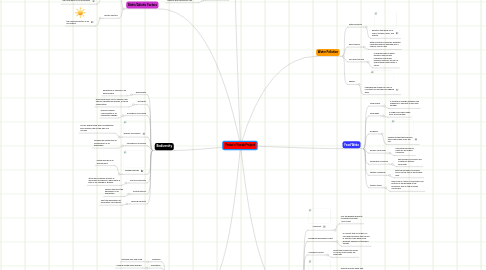
1. Levels of Organization
1.1. Organism
1.1.1. anything alive and living
1.2. Population
1.2.1. A group of the same species
1.3. Community
1.3.1. populations of organisms in one ecosystem
1.4. Ecosystem
1.4.1. many communities in an ecosystem
1.5. Biome
1.5.1. geographic region of earth inhabited by a community of plants and animals
1.6. Biosphere
1.6.1. layer of soil, water and air that sustains life, Earth
2. Biotic/Abiotic Factors
2.1. Biotic Factors
2.1.1. the living parts of an ecosystem
2.2. Abiotic Factors
2.2.1. the nonliving factors in an ecosystem
3. Biodiversity
3.1. Biodiversity
3.1.1. difference of species in an environment
3.2. hot spots
3.2.1. areas particularly rich in species, rare species, threatened species, or some combination
3.3. ecological succession
3.3.1. proces in which communities in an ecosystem change
3.4. primary succession
3.4.1. occurs where there was no vegetation ever existing, like on the side of a volcano
3.5. secondary succession
3.5.1. followed by destruction or modification of an ecosystem
3.6. pioneer species
3.6.1. native species in an environment
3.7. climax community
3.7.1. at the end of either primary or secondary succession, when there is little or no change in species
3.8. limiting factors
3.8.1. Factors that limit the population in an ecosystem
3.9. carrying capacity
3.9.1. The total population an ecosystem can support
4. Population
4.1. population growth
4.1.1. population growing over time
4.2. black plague
4.2.1. the black death was the largest population decrease in history
4.3. industrial revolution
4.3.1. the start of the increase in population, leading toward the carrying capacity.
4.3.1.1. cars
4.4. exponential growth
4.4.1. rapid growth rate over several years
4.5. sustainability
4.5.1. A biospheres ability to sustain life
4.6. logistic growth
4.6.1. restricted population growth caused by limiting factors
4.7. J-curve
4.7.1. there is no limit to population size, resulting in a j shaped graph
4.8. S-curve
4.8.1. graph that shows the effect of a limiting factor with an increase in population
4.9. population growth rate
4.9.1. a rate of population increase, 2x or 2.5x until an ecosystem's carrying capacity has reached its max
5. Biomes
5.1. rainforest
5.1.1. Has the highest diversity of animals and over 1,000 trees
5.2. temperate deciduous forest
5.2.1. is a forest that is not hot nor cold and has leaves that fall off in Autumn. they have many different species of trees and animals
5.3. coniferous forest
5.3.1. forest that creates its seeds in cones, most known are pine trees
5.4. desert
5.4.1. Deserts are hot areas that receive very little rainfall
5.5. tundra
5.5.1. extremely cold. not many plants can live there because of limited soil
5.6. grassland/savannah
5.6.1. a tropical grassland with some clumps of trees
5.7. freshwater biome
5.7.1. A Freshwater biome includes rivers, ponds, lakes, streams, creeks, and anything that is made up of fresh water
5.8. marine biome
5.8.1. includes all water that is salty, like oceans
6. Food Webs
6.1. food chains
6.1.1. A transfer in energy between one organism to the next as one eats another
6.2. food webs
6.2.1. A large food chain made from an ecosystem
6.3. producer
6.3.1. organisms that that produce their own energy from the sun
6.4. primary consumer
6.4.1. eats producers and is eaten by secondary consumer
6.5. secondary consumer
6.5.1. eats primary consumer and is eaten by tertiary consumer
6.6. tertiary consumer
6.6.1. eats the seconary consumer and is on the top of the trophic level
6.7. trophic levels
6.7.1. Each level is a layer of a pyramid. The bottom of the pyramid is the producers and on top is teriary consumers
7. Water Pollution
7.1. water pollution
7.1.1. pollution that ends up in rivers, streams, lakes, and oceans
7.2. point source
7.2.1. water pollution caused by anything untreated directly dumped into a stream, river or lake
7.3. non-point source
7.3.1. a large amount of water pollution that comes indirectly from many different sources, like car oil and fertilizer runoff after a strom
7.4. aquifer
7.4.1. underground streams on top of rock that can be taken by digging wells
